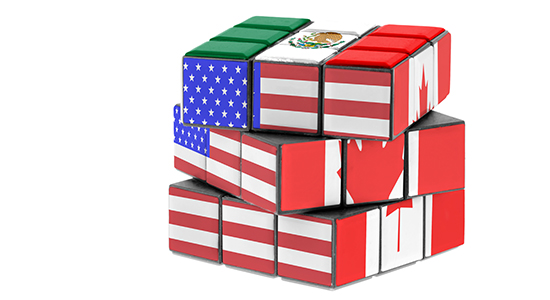
After more than 13 months of negotiations, more than nine rounds of negotiations, 34 chapters, and 13 side letters, a political push is now underway to ratify the United States-Mexico-Canada Agreement (USMCA), which will supersede the North American Free Trade Agreement (NAFTA) – if ratified and adopted by Congress.
 Ngosong Fonkem, West Virginia University College of Law 2011 (JD, MBA) and Tulane Law School 2012 (LLM), is a senior advisor at Addison-Clifton LLC, Milwaukee, where he assists U.S. and foreign companies with U.S. trade law compliance and with conducting business in Asia.
Ngosong Fonkem, West Virginia University College of Law 2011 (JD, MBA) and Tulane Law School 2012 (LLM), is a senior advisor at Addison-Clifton LLC, Milwaukee, where he assists U.S. and foreign companies with U.S. trade law compliance and with conducting business in Asia.
This follows from President Donald Trump’s campaign promise to address and fix U.S. trade imbalances with its trade partners, and, catalyzed by a series for trade actions that began at the end of 2017.1
Although the negotiation phase of the agreement has now concluded, obstacles remain, due to the perceptions that the USMCA is merely a modernization rather than a complete overhaul of NAFTA as touted by the Trump Administration.2 This begs a few questions – how different is the USMCA from NAFTA, and most importantly, what happens if it is not adopted by Congress, if it determines that it is not a better deal?
Key Changes from NAFTA to USMCA
Although the USMCA appears to be a revised NAFTA deal, there are some key changes to the original agreement. These key changes involve the following key issues:
-
Canadian Dairy Products: Canadian dairy products was not a part of the original NAFTA. Under the USMCA however, Canada will allow the U.S. an increase of 3.5 percent access to its dairy market. This is an increase of a half percent from Canadian concession under the Trans-Pacific Partnership.
-
Chapter 11 and 19 Dispute Resolution: Under NAFTA, the Chapter 11 investor-state dispute settlement provision provides a foreign investor with a private right of action against a NAFTA country through an arbitral tribunal for alleged discrimination. Chapter 19 provides a bi-national arbitration panel to review a final determination order in anti-dumping and countervailing duties matter of each NAFTA country’s trade remedy laws. The USMCA eliminates Chapter 11, with limited applicability to Mexico3, and completely maintains in tag Chapter 19, as that provision had been a red-line issue for Canada.
-
Sunset Clause: NAFTA had no time limit. Under the USMCA, the parties will formally review the deal in six years from the date of conclusion to determine whether to extend its lifespan beyond 16 years.
-
Rules of Origin Regarding Automobiles and Parts: Regarding rules of origin, if an imported good contain some non-NAFTA content, the importers would need to determine that sufficient NAFTA content was used in its manufacture before it can benefit from NAFTA duty-free treatment. NAFTA required only that a vehicle include 62.5 percent content from NAFTA countries. The USMCA increases the required content to 75 percent. Furthermore, it preserves the right of the U.S. to impose emergency tariffs of up to 25 percent on cars and car parts on grounds of national security. However, it also creates limited carve out for both Canada and Mexico, as it relates to this 25 percent national security tariff.
-
16 Dollars Minimum wage for certain auto jobs: Under the USMCA, at least 30 percent of automobiles must be made by workers earning at least $16 an hour. This requirement increases to 40 percent by 2023.
-
Cross-border Trucking: Under NAFTA, the U.S. and Mexico agreed to allow trucks from each country to carry goods across borders for long-haul deliveries, beyond the 25 miles “buffer-zone.” Mexican trucks now must meet U.S. safety standards before crossing U.S. border under the USMCA.
-
Intellectual Property Rights: The USMCA provides more protection for patents and trademarks by adopting many provisions from the Trans-Pacific Partnership.
The Next Step
Although the USMCA was finalized by all three countries on Sept. 30, 2018, the renegotiation is still far from over, as it is not yet law in the United States. A 60-day period of edits and review assessment by U.S. Trade Representative is currently underway to determine its economic impact. Upon completion, U.S. Congress shall be provided with the report along with the text for Congressional review and ratification, based on the guidelines provided under the U.S. Trade Promotion Authority Act.
What if Congress Does Not Ratify the USMCA?
If the USMCA is not ratified and adopted by the U.S. Congress, superseding NAFTA, it appears NAFTA will remain in place in its current form, as U.S. law requires the president to take affirmative action to repeal it.
Although it is universally accepted that the USMCA is better than a no-NAFTA deal, questions remain whether it is better than NAFTA and whether a Democratic Congress is likely to accept the new deal in its current form, if the upcoming November election sways in their favor. That uncertainty is a business risk.
This article was originally published on the State Bar of Wisconsin’s International Practice Section Blog. Visit the State Bar sections or the Business Law Section web pages to learn more about the benefits of section membership.
Endnotes
1 Trump’s trade actions against trading partners began at the end of 2017 with tariffs action on imported washing machines and solar panel products from China and South Korea in January 2018, according to the New York Times.
2 Sheelah Kolhatkar, “Trump’s Rebrand of NAFTA,” The New Yorker, Oct. 3, 2018.
3 The only exceptions are U.S. oil companies operating in Mexico, as the U.S. is concerned that the Mexico government may try to nationalize its oil industry again.
